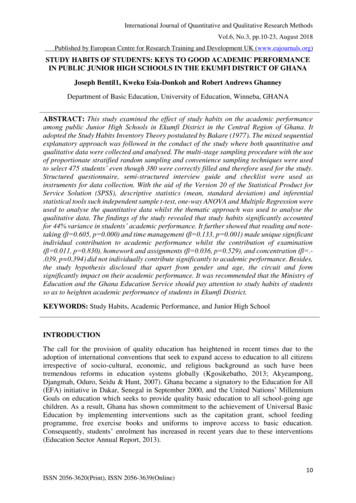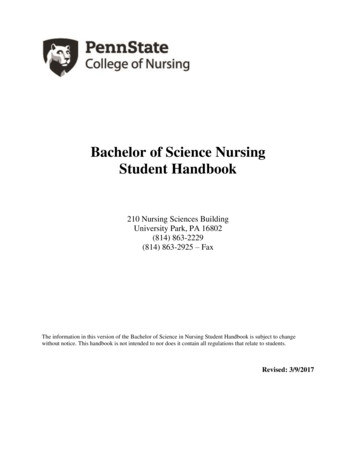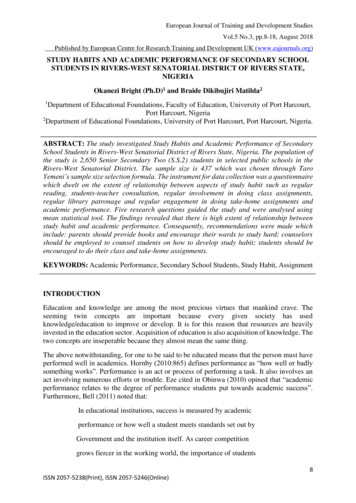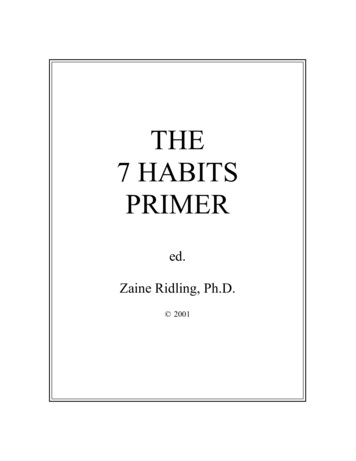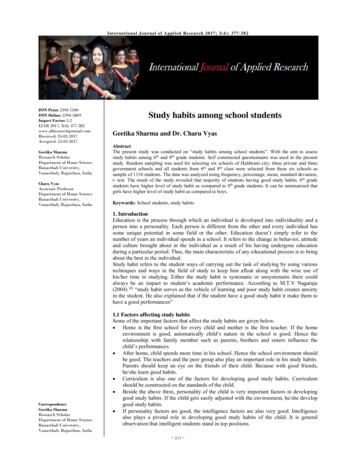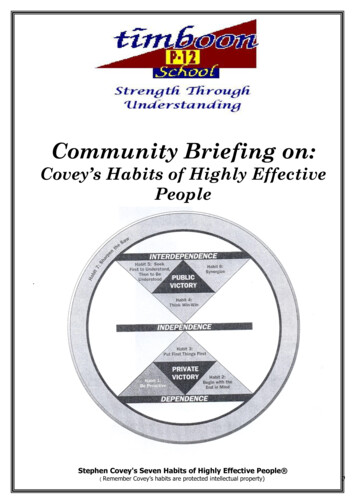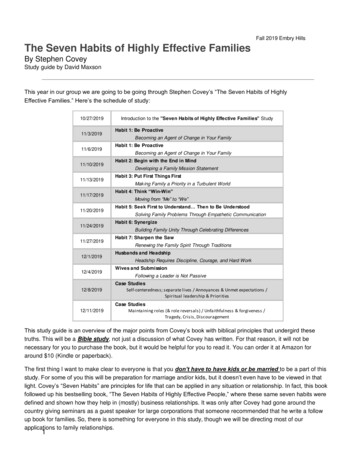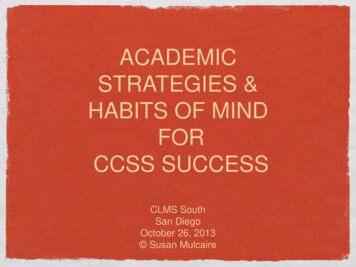
Transcription
ACADEMICSTRATEGIES &HABITS OF MINDFORCCSS SUCCESSCLMS SouthSan DiegoOctober 26, 2013 Susan Mulcaire
Susan MulcairePresident, Tween PublishingTeacherAttorneyAuthor/developer of curriculum:The Middle School Student’s Guide to Ruling the World!The Middle School Student’s Guide to Study Skills;The Middle School Student’s Guide to College;The Middle School Student’s Guide to Commerce & Careers(in development)Mother of 3
College readiness beginsat the middle level.
How a student learns isjust as important aswhat they learn.
College readiness is thecombined product ofcontent knowledge productive academic behaviorsand habits of mind.
Organizations providing insight into college-readyacademic behaviors and habits of mind:National Assessment Governing Board (www.nagb.org/)Achieve (www.achieve.org)The California Center for College and Career al Policy Improvement Center (EPIC) (www.epiconline.org/)The College Board (www.thecollegeboard.org)National Assessment of Educational g)Texas College and Career Readiness dfThe Partnership for Assessment of Readiness for College and Careers(PARCC) www.parcconline.org/
EPIC’s Keys to College and Career Readiness
EPIC’s Keys to College & CareerReadinessThe other sideof theCommon Corecoin!CCSS
ACHIEVE’Stake onthe subject
The CCSS authorizes teaching these skills as interdependent with content:“By emphasizing required achievements, the Standards leaveroom for teachers, curriculum developers, and states todetermine how those goals should be reached and whatadditional topics should be addressed. Thus, the Standards donot mandate such things as a particular writing process or the fullrange of metacognitive strategies that students may need tomonitor and direct their thinking and learning. Teachers are thusfree to provide students with whatever tools and knowledgetheir professional judgment and experience identify as mosthelpful for meeting the goals set out in the Standards.”(English Language Arts Standards, Introduction - Key DesignConsideration)
What are the benefits of providing instruction inacademic behaviors and habits of mind?Cultivates the ability to learn more deeply, meeting goals of the CCSS acrossall areas of the curriculum.Encourages independence in learning.Removes common barriers to achievement.Improves the ability to successfully participate in rigorous classes in highschool.Promotes a culture of college and career readiness in a school/district.Provides clear and consistent academic behavior standards andexpectations throughout a school/district, over the course of several years. *Provides a practical and easy way to partner with parents to promote highschool preparedness and college readiness.Reduces need for remediation in college.Not everyone needs everything, but everyone needs something!
What are the components of an effective programfor teaching good academic strategies and habits ofmind? What would you teach? In what order?Work HabitsTime ManagementOrganizationalSkillsStudy/LearningSkills AcademicBehaviors & Habitsof MindDevelopPostsecondaryAspirationsandKnowledge
?Work HabitsTime ManagementOrganizational Skills
GOALS OF AN ORGANIZATIONAL SKILLS PROGRAMAddress the habits & behaviors often at the root of underachievement atthe middle level.Target: 5/6/7 students transitioning into MS/JHS.Practical “how to” skills for success at the middle level.Don’t confuse organizational skills with study skills, or mix with socialemotional skills, or a career program.Lay the foundation for development of metacognitive/study skillsand good, long term work management practices.Establish the home/*schools* high school preparedness and collegereadiness partnership which will run though h/s graduation.Build a support system that eliminates dependency.(“Please help me figure this out.” vs. “Do this for me.”)
Here are some suggested skills and strategiesto teach in an organizational skills program. how to organize a binderhow to use a planner/e-cal systemhow to create a back up/buddy systemhow to take to-dohow to manage a group project (collaboration)how to use a rubric or project directionshow to recognize and follow up on responsibilities(self-advocacy)how to remember your stuff every day!how to manage a long term project how to keep track of homework introduce metacognition concepts(behaviors/habits/attitudes)
How do Iteachstudyskills?Study Skills
Study skills apply to all aspects oflearning, to improve a student’sability to acquire, retain, anddemonstrate knowledge.
GOALS OF A STUDY SKILLS PROGRAMTarget: 7/8 students transitioning to high school.Different from, but builds on skills learned in theorganizational skills program.Focus is on skills and strategies for deeper learning,better retention and recall, and improved ability todemonstrate knowledge.Looks to the future: Includes skills and strategies forcollege readiness and long term academic success.Continue the home/*schools* high schoolpreparedness and college readiness partnership.Integrate with core instruction, across the curriculum.
Here are some suggested skills andstrategies to teach in a study skillsprogram!Metacognition and the Process of LearningLearning Styles & IntelligencesPre-learning StrategiesActive Learning, Active Listening, Active ReadingNote-takingMemory and recall strategies.Test-taking skills and strategies.Looking forward to college -- college readiness skills.
Habituation of study skills is key!1. Share the responsibility for application (and enforcement!) ofskills.2. Encourage dialogue and discussion in the classroom about studyhabits and best practices.3. Make good study skills part of the school’s academic expectations.4. Talk about study skills at parent meetings and studentconferences.5. Incorporate good study skills and habits of mind into the schoolculture.
Develop PostsecondaryAspirationsandKnowledge
GOALS OF A COLLEGE PATH PROGRAM Grade level-appropriate introduction to postsecondary education.Target: 7/8/9 students transitioning to HS.Promote postsecondary awareness and aspirations.(Conley/EPIC)Builds knowledge of college/postsecondary norms, culture andvocabulary.Removes some of the barriers to pursuing a college educationthat students encounter in high school.Fun and student-focused.Educate parents along with students.
Suggested topics to cover in a middle schoolcollege path program: Benefits of a college/postsecondary education.Features of a college campus.Basic college choice criteria.Basic college application process.Student life on a college campus.Majors and extracurricular opportunities.Alternatives to traditional (4 year) college.Financing a college educationWhat to expect in high schoolDegrees and graduate school(Opt.) Avoiding alcohol and drug risks.
Collaboration 1. Share responsibility for college knowledgeactivities.2. Encourage dialogue, discussion and activities inthe classroom ( “Who’s brother/sister/cousin is incollege?” “ What are the ND colors and mascot?”“What’s does and A.I. major study?”)3. Keep options open, but “no plan” is not an option.4. Make postsecondary education a part of theschool’s academic expectations. Test knowledgeand terms.5. Talk about postsecondary issues at parentmeetings and student conferences.6. Make college a part of the school culture.
Preview: 2014/2015The Middle School Student’s Guide to Commerceand Careers
Thank you!Susan Mulcaire -- Booth com949-723-5131(ph)949-209-1871 (f)
The Middle School Student’s Guide to Study Skills; The Middle School Student’s Guide to College; The Middle School Student’s Guide to Commerce & Careers (in development) Mother of 3 . College readiness begins at the middle level. How


